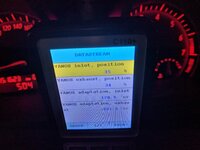Updated on this.
I completed the VANOS seal procedure yesterday and had a chance to run the tool this morning to see any differences.
I wasn't going to yet originally as I wanted to see how the car felt before being biased but after a good 20 minute drive I'm very sure the car is running differently so just had to check the numbers.
NB: It's said that the seals need some driving to settle. I will check this all again after each tank and update if anything notable changes
I also want to point out that this is a layman's attempt at understanding the VANOS system. My hope is that we can determine what "normal" looks like on a simple-to-use and cheap c110+ tool that anyone can grab to check their VANOS.
Opening up my VANOS, they definitely needed the seals changed (as most expect). Very loose fit to the cylinder walls to the point where the cylinders would probably fall out if held vertically!
My observations before checking data:
- The motor definitely revs smoother.
- I haven't given it a full whack so wouldn't be able to comment on power but there does seem to be better torque and response on take-off from low rpm.
So running the diagnostics with the C110+, here were my observations (i have not run the motor over 4500 rpm):
- The adaption angles still do not change. They have however varied from the last time I checked by .X degrees on each.
- Inlet and Exhaust position %s seem to change depending on RPM but also THROTTLE input. ie: Slow rev vs quick hard jab
- At rest (motor off), positions both return to 12%
- On idle, Inlet 37%, Exhaust 12% (previously stuck at 34%)
- On slow rev, Inlet stays around the same. Exhaust however, changes from 12% > 37%
- Under normal cruising and moderate driving, both values stay around 37% with Exhaust varying to 12% occasionally based on revs.
- On hard jab/rev, I have not worked out the pattern yet. I have seen the numbers jump between 99% and 0% for both but I'm not sure what combo of input (throttle strength / rpm) is causing it.
The only change was the position measurement (again, both inlet and exhaust) which stayed at 34-35% for both until I off throttled and it would jump to 0%, then immediately back to the 30's again.
This has certainly changed. There's no more sudden jumping on/off throttle while driving (except what I observed out of gear and jabbing the throttle).
I am sure that there are quite a few variables and rules that determine what gets varied and INPA would probably give a clearer picture of the operation. I am interested to know whether the inlet % should vary more often. If my understanding is correct, there's at least 2 "modes" for the cams - low and normal rpm. It seems low rpm for the Exhaust cam is 12% and normal is 37%. My inlet cam however, doesn't appear to go into a low mode. Hmm...
Will update this thread with any new findings over the next run-in period... and if i work out something else on the system is broke


